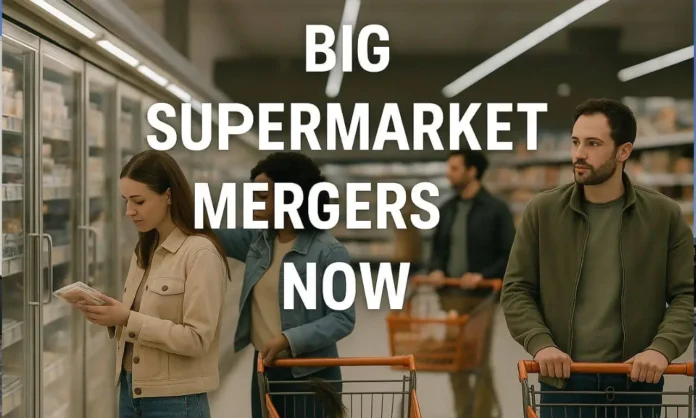Supermarket mergers are now changing how grocery chains run, expand, and buy. When chains join, supply chains change. For buyers, it means fewer choices, stronger retailers, and faster shifts.
This is not the same old story. No padded intros. No repeated structure. Just a clear breakdown of what’s happening in global food retail today.
Why supermarket mergers matter now
Retail giants are joining to stay ahead. They merge to:
- Cut operating costs
- Gain leverage with suppliers
- Expand into new markets
- Improve logistics and delivery
Supermarket mergers help chains face rising food costs, labour shortages, inflation, and e-commerce threats. These are hard realities for buyers everywhere.
Trouble in South Korea
The privately held firm MBK said in June 2025 that it plans to sell the South Korean second-largest grocery chain, Homeplus. In March 2025, Homeplus went into complicated court restructuring. Its liquidity value is higher than operating value.
In an attempt by MBK not to collapse, it partners with a buyer by canceling the existing shares and replacing them with new ones. This supermarket merger or more of a sale, has reflected on bigger trends. Buyers will have to pay attention to this. This is a new owner, and with them, there are new contracts and standards.
U.S. megamerger fallout
Kroger and Albertsons entered a proposal on merger with an attempt to have all the nearly 5,000 stores to be under same group. With the deal worth $24.6 billion dollars the regulators that opposed the deal feared its impact on price and competition. In late 2024, the transaction was blocked by courts in the U.S. This was followed by legal proceeding in the early months of 2025.
The terms on the penalty on the failed deal were challenged by Kroger. Albertsons had reacted with its claims of regulatory approval. The scenario is inconclusive and a pointer of how complicated mergers of supermarkets may be in a highly regulated market. This botched grocer merger caused concern with regards to antitrust enforcement. The future deals are likely to have more rigid reviews and potential divestment of the stores by the international buyers.
Cross-border moves in Europe
Baltic shift
In March 2025, Denmark’s Salling Group agreed to acquire Rimi Baltic from Sweden’s ICA Gruppen for €1.3 billion. The EU approved, and the merger is expected to finalize by June 2025. This supermarket merger marks a major regional consolidation. It will combine hundreds of stores across Lithuania, Latvia, and Estonia under one roof. Buyers can expect a unified procurement team, but also new rules.
UK regulator reset
In February 2025, the UK government refocused the Competition & Markets Authority (CMA) mandate. Now it only blocks deals that harm consumers directly. That means larger supermarket mergers may now get approval. Deals like Sainsbury’s‑Asda (£7 billion blocked in 2019) could reemerge.
After the CMA update, analysts warned supermarket mergers now face fewer barriers—but buyers must watch chain power.
Western Europe shake‑ups
France’s Carrefour is retooling its structure after selling Taiwan assets and focusing on core markets. More notably, Carrefour acquired SuperCor in Spain and sold Casino stores in France to Aldi Nord in December 2022. These supermarket mergers show strategic repositioning.
Aldi’s U.S. push
Aldi Süd has been aggressive in North America. After buying Winn‑Dixie and Harveys in 2023–2024, Aldi divested about 170 stores in February 2025 back to Southeastern Grocers and C&S Wholesale. It plans to convert 220 into Aldi formats by 2027. This reflects a phased supermarket merger strategy: buy, restructure, rebrand.
For suppliers, that means adapting to Aldi’s strict private‑label protocols and fast inventory shifts.
Bread sector talks in the UK
In May 2025, talks began on a bread merger involving Hovis and Kingsmill in the UK. This is not a grocery store merger, but it impacts supermarket shelf supply. Combined sales would surpass £878 million. Regulatory review is expected due to its impact on product choice and pricing.
International buyers must track non‑store mergers too. Bread brands often supply multiple chains.
Global merger trends in 2025
A recent study noted more grocery deals above $1 billion in 2024 than ever. Deals over $5 billion also rose. This reflects resilience in buyer‑driven consolidation.
Experts forecast continued supermarket mergers during 2025–2026. Some expect activity to slow mid‑year amid economic uncertainty. Yet buyer fatigue and regulatory caution may be brief.
Top Effects of Supermarket Mergers (2024–25)

- Fewer rival chains per region
- Higher store counts under single banners
- Centralised purchasing teams
- Faster shifts to private‑label
- Increased supplier compliance demands
Table: Key supermarket mergers 2024–2025
| Region | Example Deal | Aim |
|---|---|---|
| South Korea | MBK selling Homeplus | Rescue & restructure |
| U.S. | Kroger‑Albertsons (failed) | Scale, but hit antitrust |
| Baltic states (EU) | Salling Group + Rimi Baltic | Cross‑border strength |
| France/Spain | Carrefour deals with SuperCor, Casino | Focused expansion & retreat |
| U.S. Aldi strategy | Aldi + Winn‑Dixie / Harveys | Conversion & rebranding |
| UK bread brands | Hovis + Kingsmill (pending) | Brand consolidation |
What buyers must do
- Track deal filing and approvals
Register new supermarket mergers early. Monitor local and supra‑national regulators. - Anticipate category changes
Merged chains may streamline SKUs or drop overlapping items. Sellers need agility. - Update compliance systems
Centralised buyers will demand tighter quality, safety, and traceability documentation. - Renegotiate terms
Merged chains gift buying power. Expect tougher price, margin, and lead‑time negotiations. - Expand channel thinking
Non-supermarket mergers (bread, online grocery) change supply demands—and shelf inclusion.
More pressure for international suppliers
The pace of supermarket mergers means global suppliers must now rethink how they work. Many buyers are consolidating vendor lists. Some suppliers may lose listings if they do not meet new volume, cost, or compliance targets.
Private label expansion is also increasing pressure. Merged chains are reducing branded shelf space in favour of owned labels. This affects brand visibility and volume forecasts. Suppliers must respond quickly or risk exclusion.
Contract cycles are shrinking
In many cases, supermarket mergers are shortening contract cycles. New leadership means new reviews. Vendors used to multi-year agreements are now seeing quarterly reassessments. That means faster pricing updates, real-time inventory reporting, and constant delivery accuracy.
Smaller suppliers face new risks
Mergers may favour large multinational suppliers who can absorb cost demands and scale up fast. Local and mid-size vendors could face tighter margins or new onboarding hurdles.
For international buyers, this means tracking not just mergers—but also who remains in the supplier network after consolidation.
The big picture ahead
Supermarket mergers are not slowing. Chains are leaning harder into scale and efficiency. International buyers must change accordingly—tracking deals, preparing for contracts, and strengthening supply operations.
The landscape is more concentrated. Competition is fiercer. Buyers who adapt quickly will find stability. Those who don’t may lose shelf access or face tougher negotiations.
Supermarket mergers are reshaping global food retail. For international buyers, knowing who merges, why, and how is essential to staying valuable.
Supermarket mergers will drive the next phase of retail buying.



